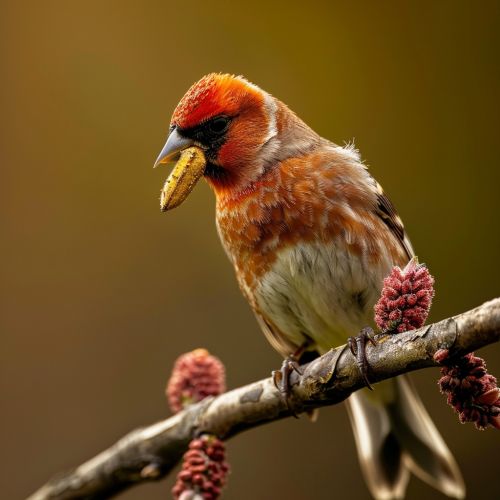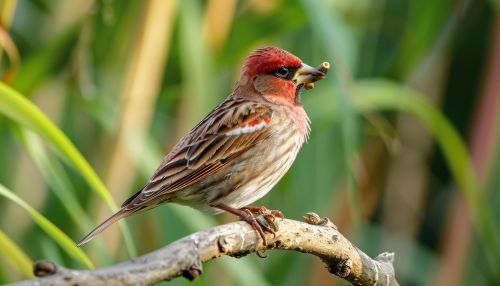Granivorous: Difference between revisions
(Created page with "== Overview == Granivorous organisms are those that primarily consume grains and seeds as their main source of nutrition. This dietary specialization is observed across a wide range of taxa, including birds, mammals, insects, and even some reptiles. The term "granivorous" is derived from the Latin words "granum" (grain) and "vorare" (to devour). Granivory is a significant ecological interaction that influences plant community dynamics, seed dispersal mechanisms, and the...") |
No edit summary |
||
| Line 3: | Line 3: | ||
Granivorous organisms are those that primarily consume grains and seeds as their main source of nutrition. This dietary specialization is observed across a wide range of taxa, including birds, mammals, insects, and even some reptiles. The term "granivorous" is derived from the Latin words "granum" (grain) and "vorare" (to devour). Granivory is a significant ecological interaction that influences plant community dynamics, seed dispersal mechanisms, and the evolutionary strategies of both plants and their consumers. | Granivorous organisms are those that primarily consume grains and seeds as their main source of nutrition. This dietary specialization is observed across a wide range of taxa, including birds, mammals, insects, and even some reptiles. The term "granivorous" is derived from the Latin words "granum" (grain) and "vorare" (to devour). Granivory is a significant ecological interaction that influences plant community dynamics, seed dispersal mechanisms, and the evolutionary strategies of both plants and their consumers. | ||
[[Image:Detail-91917.jpg|thumb|center|A granivorous bird, such as a finch, perched on a branch with a seed in its beak.|class=only_on_mobile]] | |||
[[Image:Detail-91918.jpg|thumb|center|A granivorous bird, such as a finch, perched on a branch with a seed in its beak.|class=only_on_desktop]] | |||
== Taxonomic Distribution == | == Taxonomic Distribution == | ||
Latest revision as of 01:21, 19 June 2024
Overview
Granivorous organisms are those that primarily consume grains and seeds as their main source of nutrition. This dietary specialization is observed across a wide range of taxa, including birds, mammals, insects, and even some reptiles. The term "granivorous" is derived from the Latin words "granum" (grain) and "vorare" (to devour). Granivory is a significant ecological interaction that influences plant community dynamics, seed dispersal mechanisms, and the evolutionary strategies of both plants and their consumers.


Taxonomic Distribution
Birds
Birds are perhaps the most well-known granivorous organisms. Many species within the order Passeriformes (perching birds) exhibit granivory. Notable examples include finches, sparrows, and canaries. These birds possess specialized beaks adapted for cracking seeds. The House Finch (Haemorhous mexicanus), for instance, has a conical beak that allows it to efficiently process a variety of seeds.
Mammals
Among mammals, rodents are the primary granivorous group. Species such as mice, rats, and squirrels have evolved various adaptations to exploit seeds as a food resource. Their incisors are well-suited for gnawing through tough seed coats. The Eastern Gray Squirrel (Sciurus carolinensis) is a classic example, known for its behavior of caching seeds for later consumption.
Insects
Insects also exhibit granivory, with many species of beetles and ants specializing in seed consumption. The Harvester Ant (Pogonomyrmex spp.) collects and stores seeds in its nests, playing a crucial role in seed dispersal and soil aeration. Certain beetles, such as those in the family Bruchidae, are known for their larval stages that develop within seeds, consuming the endosperm and embryo.
Reptiles
While less common, some reptiles are granivorous. Certain species of tortoises, such as the Desert Tortoise (Gopherus agassizii), consume seeds as part of their diet. These reptiles often contribute to seed dispersal through their fecal matter, which contains viable seeds that can germinate.
Ecological Impact
Granivory has profound ecological implications. Seed predation by granivorous organisms can significantly influence plant population dynamics. By consuming seeds, these organisms can reduce the seed bank, thereby affecting plant recruitment and community composition. Conversely, some granivores act as seed dispersers, facilitating the spread of plant species across the landscape.
Seed Dispersal
Seed dispersal by granivores can occur through various mechanisms. Birds and mammals often transport seeds away from the parent plant, either by carrying them in their beaks or mouths or by caching them in different locations. This behavior can lead to the establishment of new plant populations in suitable habitats. For example, the Clark's Nutcracker (Nucifraga columbiana) is known for its role in dispersing the seeds of Whitebark Pine (Pinus albicaulis), a keystone species in alpine ecosystems.
Seed Predation
Seed predation by granivores can exert selective pressures on plants, leading to the evolution of various defensive strategies. Some plants produce chemical deterrents, such as alkaloids and tannins, to reduce seed palatability. Others develop physical defenses, such as thick seed coats or spines, to protect their seeds from being consumed. The Acacia tree, for instance, produces seeds with hard coats that are difficult for granivores to penetrate.
Adaptations of Granivorous Organisms
Granivorous organisms exhibit a range of morphological, physiological, and behavioral adaptations that enable them to efficiently exploit seeds as a food resource.
Morphological Adaptations
Morphological adaptations in granivores are often centered around their feeding apparatus. Birds, for example, have evolved a variety of beak shapes and sizes to handle different types of seeds. The Crossbill (Loxia spp.) has a unique crossed bill that allows it to extract seeds from conifer cones. Similarly, rodents possess strong, ever-growing incisors that enable them to gnaw through tough seed coats.
Physiological Adaptations
Physiological adaptations in granivores include specialized digestive systems that can process seeds efficiently. Some birds have a muscular gizzard that grinds seeds into smaller, more digestible pieces. Insects like the Seed Beetle (Bruchidae) have enzymes that break down seed toxins, allowing them to consume seeds that would be harmful to other organisms.
Behavioral Adaptations
Behavioral adaptations in granivores often involve strategies for locating, harvesting, and storing seeds. Many birds and mammals exhibit caching behavior, where they store seeds in hidden locations for future use. This behavior not only ensures a steady food supply but also aids in seed dispersal. The Eurasian Jay (Garrulus glandarius) is known for its ability to remember the locations of thousands of cached acorns.
Evolutionary Dynamics
The evolutionary dynamics between granivores and plants are characterized by a complex interplay of mutualism and antagonism. While granivores benefit from consuming seeds, plants may experience both positive and negative effects from this interaction.
Coevolution
Coevolution between granivores and plants has led to the development of reciprocal adaptations. Plants may evolve traits that either deter seed predation or enhance seed dispersal. Granivores, in turn, may develop counter-adaptations to overcome plant defenses. This coevolutionary arms race can result in highly specialized relationships, such as that between the Yucca Moth (Tegeticula spp.) and Yucca plants, where the moth both pollinates the plant and lays its eggs in the seeds.
Mutualism
In some cases, the relationship between granivores and plants is mutualistic. Granivores may provide essential services such as seed dispersal, which can enhance plant reproductive success. The Mutualistic Relationship between the Clark's Nutcracker and the Whitebark Pine is a prime example, where the bird's seed-caching behavior facilitates the tree's regeneration.
Antagonism
Conversely, granivory can also be antagonistic, with granivores acting as seed predators that reduce plant fitness. Plants may respond by evolving defensive traits to protect their seeds. The Red Queen Hypothesis suggests that this ongoing evolutionary struggle drives the continuous adaptation of both granivores and plants.
Human Impacts
Human activities have significantly influenced granivorous interactions and the ecosystems they inhabit. Agricultural practices, habitat destruction, and climate change are among the factors that affect granivorous species and their food resources.
Agriculture
Agriculture has both positive and negative impacts on granivorous species. On one hand, the cultivation of cereal crops provides abundant food resources for granivores. On the other hand, the use of pesticides and habitat modification can negatively affect granivorous populations. The House Sparrow (Passer domesticus), for example, has benefited from agricultural landscapes, while other species have declined due to habitat loss.
Habitat Destruction
Habitat destruction, such as deforestation and urbanization, can lead to the decline of granivorous species by reducing the availability of natural seed resources. The Spotted Owl (Strix occidentalis), which relies on old-growth forests, is an example of a species affected by habitat loss. Conservation efforts aimed at preserving natural habitats are crucial for maintaining granivorous populations.
Climate Change
Climate change poses a significant threat to granivorous species by altering the availability and distribution of seeds. Changes in temperature and precipitation patterns can affect plant phenology, leading to mismatches between seed production and granivore feeding periods. The Pinyon Jay (Gymnorhinus cyanocephalus), which depends on Pinyon Pine seeds, is vulnerable to climate-induced changes in seed availability.
Conservation and Management
Effective conservation and management strategies are essential for protecting granivorous species and their habitats. These strategies often involve habitat restoration, sustainable agricultural practices, and the establishment of protected areas.
Habitat Restoration
Habitat restoration efforts aim to recreate natural environments that support granivorous species. This can involve reforestation, wetland restoration, and the creation of wildlife corridors. For example, the restoration of Prairie Ecosystems can benefit granivorous birds such as the Greater Prairie-Chicken (Tympanuchus cupido).
Sustainable Agriculture
Sustainable agricultural practices can help mitigate the negative impacts of farming on granivorous species. Techniques such as integrated pest management, crop rotation, and the use of cover crops can enhance biodiversity and provide food resources for granivores. The implementation of Agroforestry systems, which integrate trees and shrubs into agricultural landscapes, can also support granivorous wildlife.
Protected Areas
The establishment of protected areas is a key strategy for conserving granivorous species and their habitats. National parks, wildlife reserves, and conservation easements can provide safe havens for granivores and ensure the preservation of critical seed resources. The Kakadu National Park in Australia, for instance, supports a diverse array of granivorous birds and mammals.
